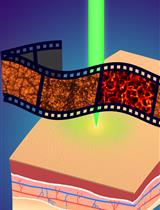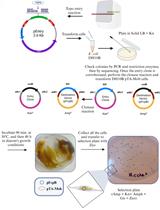- EN - English
- CN - 中文
Acid Hydrolysis for the Extraction of Archaeal Core Lipids and HPLC-MS Analysis
酸水解法提取古生菌核心脂质及HPLC-MS分析
发布: 2021年08月20日第11卷第16期 DOI: 10.21769/BioProtoc.4118 浏览次数: 2437
评审: Alba BlesaKevin BeckerAnonymous reviewer(s)

相关实验方案

利用改进的培养方法和生长监测对嗜盐火山生菌进行表型分析的次氯酸盐胁迫试验
Paula Mondragon [...] Julie A. Maupin-Furlow
2022年11月20日 1517 阅读
Abstract
Lipid membranes are essential cellular elements as they provide cellular integrity and selective permeability under a broad range of environmental settings upon cell growth. In particular, Archaea are commonly recognized for their tolerance to extreme conditions, which is now widely accepted to stem from the unique structure of their lipids. While enhancing the stability of the archaeal cell membrane, the exceptional properties of archaeal lipids also hinder their extraction using regular procedures initially developed for bacterial and eukaryotic lipids. The protocol described here circumvents these issues by directly hydrolyzing the polar head group(s) of archaeal lipids and extracting the resulting core lipids. Although leading to a loss of information on the nature of polar heads, this procedure allows the quantitative extraction of core lipids for most types of archaeal cells in an efficient, reproducible, and rapid manner.
Keywords: Archaea (古生菌)Background
Although found in all biotopes on Earth, Archaea are known as the main inhabitants of the most extreme environments, be it due to temperature, pH, salinity, hydrostatic pressure, or other environmental stressors (Komatsu and Chong, 1998; Baba et al., 1999). This ability to cope with multiple extreme conditions has been associated with one of their most diagnostic features, i.e., the unique structure of their membrane lipids. Indeed, instead of the typical lipids commonly found in Bacteria and Eukarya, which are built upon straight fatty-acyl chains ester-linked to a glycerol backbone in a sn-1,2 configuration, archaeal lipids contain polyisoprenoid alkyl chains that are ether-linked to a glycerol in a sn-2,3 configuration (De Rosa and Gambacorta, 1988). While polyisoprenoid alkyl chains provide greater membrane packing and impermeability compared to fatty acyl chains due to their heavy branching (Komatsu and Chong, 1998), ether bonds are more chemically and thermally resistant than ester linkages and less polar (Baba et al., 1999), both contributing to the enhanced stability of archaeal membranes. In addition, most Archaea are also capable of synthesizing both bilayer-forming diether lipids (one polar moiety) and membrane-spanning tetraether lipids (two polar moieties), the latter generating membrane monolayers that are even more rigid and impermeable than archaeal bilayers (Chong, 2010). In contrast to their core lipids, the polar head groups of archaeal lipids remain very similar to those of Bacteria and Eukarya, with phospho- and glyco-lipids deriving from sugars (glycerol, inositol, glucose, and N-acetylhexosamine) (Jensen et al., 2015), aminoacids (serine and ethanolamine) (Koga et al., 1993), or combinations of both (Koga et al., 1993). Although substantial lipidomes, e.g., containing up to 100 structures, have been described for Archaea (e.g., Elling et al., 2017; Bale et al., 2019), those remain less diverse than the lipidomes of Bacteria and Eukarya, which comprise hundreds to thousands of different lipid structures (Gerl et al., 2012). In addition to this large difference between archaeal and other typical lipidomes, several studies have reported biases in archaeal lipid extraction and detection (Huguet et al., 2010; Cario et al., 2015), suggesting that a significant part of the archaeal lipidome might remain inaccessible to current methodologies. The absence of procedures to completely extract and analyze archaeal lipids currently hinders our understanding of their membrane physiology and adaptation. However, partial comprehension of these phenomena can easily and reproducibly be obtained by the removal of the lipids’ polar head groups, granting access to exhaustive, and thus precise, archaeal core lipid compositions (De Rosa et al., 1980; Trincone et al., 1992; Hopmans et al., 2000; Cario et al., 2015).
Materials and Reagents
PyrexTM tubes with PTFE caps (Fisher Scientific, catalog number: 10004654)
Glass pipettes and hand pump (Fisher Scientific, catalog number: 11546963)
1 ml-glass syringe (gastight Series 1000; Hamilton, catalog number: 81320)
PTFE glass vial caps (Agilent Technologies, catalog number: 5182-0719)
Glass bottles (Dutscher, catalog number: 090971)
50-ml round bottomed flasks (Fisher Scientific, catalog number: CG150689)
Glass funnels (DWK Life Sciences, catalog number: 213514609)
2 ml-glass vials (Sodipro, catalog number: 2108081)
Freeze-dried archaeal biomass
Sand (VWR, catalog number: 27460.364)
Glass wool (Fisher Scientific, catalog number: 12373866)
CeliteTM (ACROS Organics, catalog number: 349675000)
Silica gel Geduran Si 60® (Merck, catalog number 1.11567)
Hydrochloric acid 37% (HCl; Fisher Scientific, catalog number: 10294190)
Deionized water (H2O)
Methanol (MeOH; ACROS Organics, catalog number: 364390025)
Dichloromethane (DCM; ACROS Organics, catalog number: 326850025)
Acetone (ACROS Organics, catalog number: 444150050)
n-Heptane (Hept; ACROS Organics, catalog number: 364360025)
Isopropyl alcohol (or propan-2-ol; IPA; ACROS Organics, catalog number: 184130250)
Equipment
Oven (up to 450°C)
Vacuum pump (Edwards Vacuum, catalog number: A34317984)
Note: Here, we used a vacuum pump at 50 Hz with a maximum displacement of 20.5 m3 h-1, a maximum pumping speed of 17.0 m3 h-1, and an ultimate vacuum of 2 × 10-2 mbar. Although a strong suction power allows for a faster procedure, any vacuum pump able to reach an ultimate vacuum below 20 mbar can be used.
Rotary evaporator (Büchi, models: Rotavapor RE 111; heating bath, B-491)
Note: Any rotary evaporator compatible with your vacuum pump and heating bath up to 50°C can be used.
N2 drying system
Note: Here, we connected our building N2 supply (Air Products, CryoEase® supply system) to a distributing system consisting of polycarbonate tubes (Cole-Parmer, catalog number: FV-30526-18) and splitting valves (Cole-Parmer, catalog number: FV-30600-02) ending on needles (BD, catalog number: 300700) or glass pipettes. Refer to Figure 3 for a depiction of the system.
High performance liquid chromatography (HPLC) instrument
Note: Here, we used a HP 1100 series LC system equipped with binary pumps (Agilent G1312A), a solvent degasser (Agilent G1379A), an autoinjector (Agilent G1913A), a thermostated column compartment (Agilent G1316A), and Chemstation chromatography manager software (Agilent Technologies Rev. A.09.03). However, any HPLC system that can function with a solvent gradient can be used.
Prevail Cyano 3 microns column (150 mm × 2.1 mm; Grace Davison Discovery Sciences, VWR, catalog number: HICH99243)
Note: When not used, our column was stored in Hept/IPA (95:5, v/v). However, the solvent mixture allows for both the storage and equilibration of the column and thus depends on the separation gradient (see Step D4). It might hence be adjusted to your requirements.
Mass spectrometer equipped with an ion trap and an atmospheric pressure chemical ionization (APCI) source
Note: Here, we used an Ion Trap MS Esquire 3000Plus (Bruker Daltonics, GE0100-G552) and an Agilent APCI source (Agilent G1947A), but any Mass spectrometry (MS) instrument equipped with an APCI source can be used.
Software
Mass spectrum and chromatogram processing software.
Note: Here, we used the Compass Data Analysis software (version 5.0, 2017) provided by Bruker Daltonics, but any mass spectrum and chromatogram processing software, especially the one provided by your HPLC-MS instrument manufacturer, can be used.
Procedure
文章信息
版权信息
© 2021 The Authors; exclusive licensee Bio-protocol LLC.
如何引用
Tourte, M., Schaeffer, P., Grossi, V. and Oger, P. M. (2021). Acid Hydrolysis for the Extraction of Archaeal Core Lipids and HPLC-MS Analysis. Bio-protocol 11(16): e4118. DOI: 10.21769/BioProtoc.4118.
分类
微生物学 > 微生物生物化学 > 其它化合物
微生物学 > 微生物生理学 > 细胞壁
生物化学 > 其它化合物
您对这篇实验方法有问题吗?
在此处发布您的问题,我们将邀请本文作者来回答。同时,我们会将您的问题发布到Bio-protocol Exchange,以便寻求社区成员的帮助。
Share
Bluesky
X
Copy link











